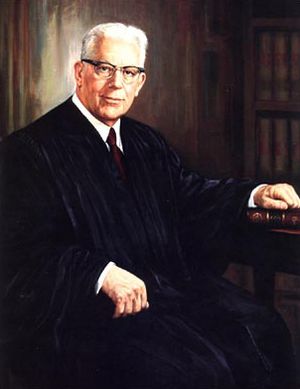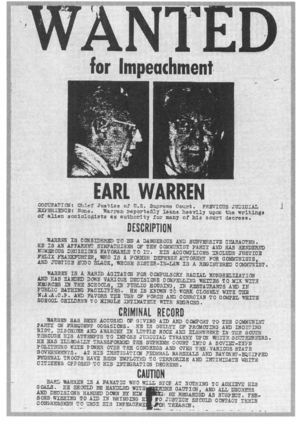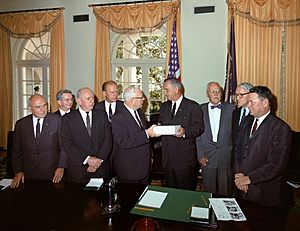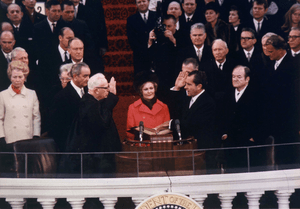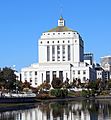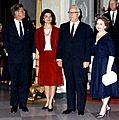Earl Warren facts for kids
Quick facts for kids
Earl Warren
|
|
|---|---|

Official portrait, 1953
|
|
| 14th Chief Justice of the United States | |
| In office October 5, 1953 – June 23, 1969 |
|
| Nominated by | Dwight D. Eisenhower |
| Preceded by | Fred M. Vinson |
| Succeeded by | Warren E. Burger |
| 30th Governor of California | |
| In office January 4, 1943 – October 5, 1953 |
|
| Lieutenant | Frederick F. Houser Goodwin Knight |
| Preceded by | Culbert Olson |
| Succeeded by | Goodwin Knight |
| 20th Attorney General of California | |
| In office January 3, 1939 – January 4, 1943 |
|
| Governor | Culbert Olson |
| Preceded by | Ulysses S. Webb |
| Succeeded by | Robert W. Kenny |
| Chair of the California Republican Party | |
| In office 1932–1938 |
|
| Preceded by | Louis B. Mayer |
| Succeeded by | Justus Craemer |
| District Attorney of Alameda County | |
| In office 1925–1939 |
|
| Preceded by | Ezra Decoto |
| Succeeded by | Ralph Hoyt |
| Personal details | |
| Born | March 19, 1891 Los Angeles, California, U.S. |
| Died | July 9, 1974 (aged 83) Washington, D.C., U.S. |
| Resting place | Arlington National Cemetery |
| Political party | Republican |
| Spouse |
Nina Meyers
(m. 1925) |
| Children | 6 |
| Education | University of California, Berkeley (BA, LLB) |
| Signature |  |
| Military service | |
| Allegiance | United States |
| Branch/service | United States Army |
| Years of service | 1917–1918 |
| Rank | |
| Unit | 91st Division |
Earl Warren (March 19, 1891 – July 9, 1974) was an important American lawyer, politician, and judge. He served as the 14th Chief Justice of the United States from 1953 to 1969. During his time, the Warren Court made big changes to how the U.S. Constitution was understood. Many people call this a "Constitutional Revolution." Warren wrote the main decisions in famous cases like Brown v. Board of Education (1954), Reynolds v. Sims (1964), Miranda v. Arizona (1966), and Loving v. Virginia (1967).
Warren also led the Warren Commission, a special group that looked into the 1963 killing of President John F. Kennedy. Before becoming Chief Justice, he was the Governor of California from 1943 to 1953. He is the last Chief Justice who held an elected office before joining the Supreme Court. Earl Warren is seen as one of the most important Supreme Court justices and political leaders in American history.
Contents
Who Was Earl Warren?
Earl Warren was born in 1891 in Los Angeles, California. He grew up in Bakersfield, California. After studying law at the University of California, Berkeley, he started his legal career in Oakland. In 1920, he became a deputy district attorney for Alameda County. He was then appointed district attorney in 1925.
Warren became a leader in the state's Republican Party. In 1938, he was elected Attorney General of California. During World War II, he supported the forced removal and internment of over 100,000 Japanese Americans. In the 1942 election, Warren became Governor of California. He served from 1943 to 1953, a time when California grew a lot. He is the only California governor to be elected for three terms in a row.
In 1948, Warren was the running mate for Thomas E. Dewey in the presidential election. But they lost to President Harry S. Truman. Warren also tried to become president in 1952. However, the Republican Party chose General Dwight D. Eisenhower. After Eisenhower won the presidency, he appointed Warren as Chief Justice.
Chief Justice of the United States Supreme Court
Becoming Chief Justice: A New Role
In 1952, after Dwight D. Eisenhower won the presidential election, he promised to appoint Earl Warren to the next open spot on the Supreme Court of the United States. When Chief Justice Fred M. Vinson died in September 1953, Eisenhower kept his promise. He chose Warren to lead the highest court in the country.
Eisenhower believed Warren was a good choice because he had many years of experience in public service. He described Warren as a "liberal-conservative" who had the right kind of thinking for the Supreme Court. Warren was confirmed by the Senate in March 1954. He was the first Scandinavian-American to be appointed to the Supreme Court.
Leading the Court: Warren's Style

When Warren became Chief Justice, the other judges on the Supreme Court had different ideas about how the courts should work. Some believed judges should not get too involved in making policies. Others, like Hugo Black and William O. Douglas, thought courts should be more active in protecting people's rights. Warren agreed with the idea that the courts should work to ensure justice.
Warren was good at bringing judges together and convincing them to agree. He believed the Constitution protected people's natural rights. He felt the Court had a special job to protect these rights. While his legal writings were sometimes seen as not perfectly clear, his ability to lead and unite the Court was very strong.
Major Decisions of the Warren Court
Ending Segregation: Brown v. Board of Education
One of Warren's first and most important cases was Brown v. Board of Education. This case challenged Jim Crow laws in the Southern United States. These laws forced racial segregation in public places, including schools. An older Supreme Court case, Plessy v. Ferguson (1896), had said that segregation was allowed if facilities were "separate but equal."
Warren strongly believed that segregation was wrong. He worked hard to get all nine Supreme Court justices to agree to overturn Plessy. He succeeded, and in May 1954, the Court decided that racial segregation in public schools was unconstitutional. This decision was a huge step towards ending segregation in America. After Brown, the Warren Court continued to issue rulings that helped end the Jim Crow system. For example, in Heart of Atlanta Motel, Inc. v. United States (1964), the Court supported the Civil Rights Act of 1964. This law banned racial segregation in public places like hotels.
Protecting Individual Rights: The Bill of Rights
In the 1960s, the Warren Court made many landmark decisions that changed criminal procedure and other areas of law. Many of these decisions applied the Bill of Rights to state and local governments. This meant that the protections in the Bill of Rights, like freedom of speech and the right to a fair trial, now applied to everyone, no matter where they lived.
- Gideon v. Wainwright (1963) said that if you are accused of a serious crime, you have the right to a lawyer, even if you cannot afford one.
- Miranda v. Arizona (1966) required police to tell suspects their rights (like the right to remain silent) when they are arrested. These are now known as Miranda warnings.
- Griswold v. Connecticut (1965) established a constitutional right to privacy.
- Loving v. Virginia (1967) struck down state laws that banned marriage between people of different races. Warren was very happy about this decision.
- New York Times Co. v. Sullivan (1964) made it harder for public officials to sue for libel, protecting freedom of the press.
- Tinker v. Des Moines Independent Community School District (1969) said that students have freedom of speech rights in school, like wearing armbands to protest.
Fair Voting: "One Person, One Vote"
The Warren Court also made important decisions about how voting districts are set up. In many states, some voting districts had many more people than others. This meant that a vote in a small district counted for more than a vote in a large district.
In Baker v. Carr (1962), the Court decided that federal courts could get involved in these issues. Then, in Reynolds v. Sims (1964), Warren wrote that state legislative districts must have roughly equal populations. He famously said, "legislators represent people, not trees or acres." This established the principle of "one man, one vote," meaning everyone's vote should count equally. This decision led to fairer representation across the country.
Controversy and Criticism
Some of the Warren Court's decisions, especially those about prayer in schools (like Engel v. Vitale in 1962) and criminal procedure, caused a lot of debate. Some people, especially conservatives, criticized the Court for being too active and making laws instead of just interpreting them. Despite this, most of the Warren Court's major decisions have remained in place.
The Warren Commission
After President John F. Kennedy was assassinated in November 1963, President Lyndon B. Johnson asked Chief Justice Warren to lead a special commission to investigate the killing. This group became known as the Warren Commission.
From December 1963 to October 1964, Warren worked as both Chief Justice and chairman of this commission. He wanted the investigation to be fair and thorough. The Commission looked into many details of the assassination.
The Warren Commission concluded that Lee Harvey Oswald acted alone in killing President Kennedy. Warren believed this conclusion was correct. He later wrote in his memoirs that the facts of the assassination were simple, even though many people thought it must be more complicated.
Retirement and Final Years
By 1968, Warren was ready to retire. He wanted to travel and leave the Court before he became too old to do his best work. He also worried that Richard Nixon might become president and appoint a conservative judge to replace him. So, he sent his resignation letter to President Johnson in June 1968.
Johnson tried to appoint another judge, but the Senate blocked the nomination. When Nixon won the 1968 election, Warren agreed to retire in June 1969. Nixon then appointed Warren E. Burger as the new Chief Justice. Warren later said he regretted retiring, wishing he had stayed on the Court longer. He wanted the Court to be remembered as "the people's court."
Earl Warren died on July 9, 1974, at the age of 83. Just hours before he passed away, he learned that the Supreme Court had voted unanimously to make President Nixon release tapes related to the Watergate scandal. This news brought him comfort. He was buried at Arlington National Cemetery.
Earl Warren's Legacy

Earl Warren is widely seen as one of the most important and influential figures in American legal and political history. His time as Chief Justice, known as the Warren Court, is often called a "Constitutional Revolution." It brought about big changes that supported freedom, democracy, and human rights.
Many experts compare Warren to other great Chief Justices like John Marshall. They say he deeply believed in equal justice for all. In 1958, Martin Luther King Jr. sent Warren a copy of his book, Stride Toward Freedom. He wrote in it, "In appreciation for your genuine good-will, your great humanitarian concern, and your unswerving devotion to the sublime principles of our American democracy."
While some critics felt the Warren Court went too far in its decisions, many of its landmark rulings, like those on civil rights and voting rights, are still important parts of American law today.
Memorials and Honors
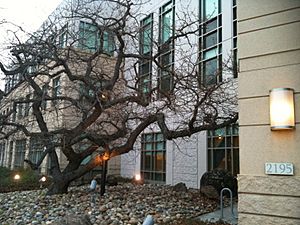
Earl Warren received the Presidential Medal of Freedom after his death in 1981. This is one of the highest civilian awards in the United States. He was also honored with a U.S. postage stamp. In 2007, he was inducted into the California Hall of Fame.
Many places are named after him, including:
- "Earl Warren Hall" at the University of California, Berkeley, his old school.
- The Earl Warren Building in San Francisco, which is the headquarters of the Supreme Court of California.
- Earl Warren College at the University of California, San Diego.
- Several schools, including Warren High School in Downey, California, and Earl Warren Middle School in Solana Beach, California.
Images for kids
-
California Attorney General Earl Warren
See also
 In Spanish: Earl Warren para niños
In Spanish: Earl Warren para niños


